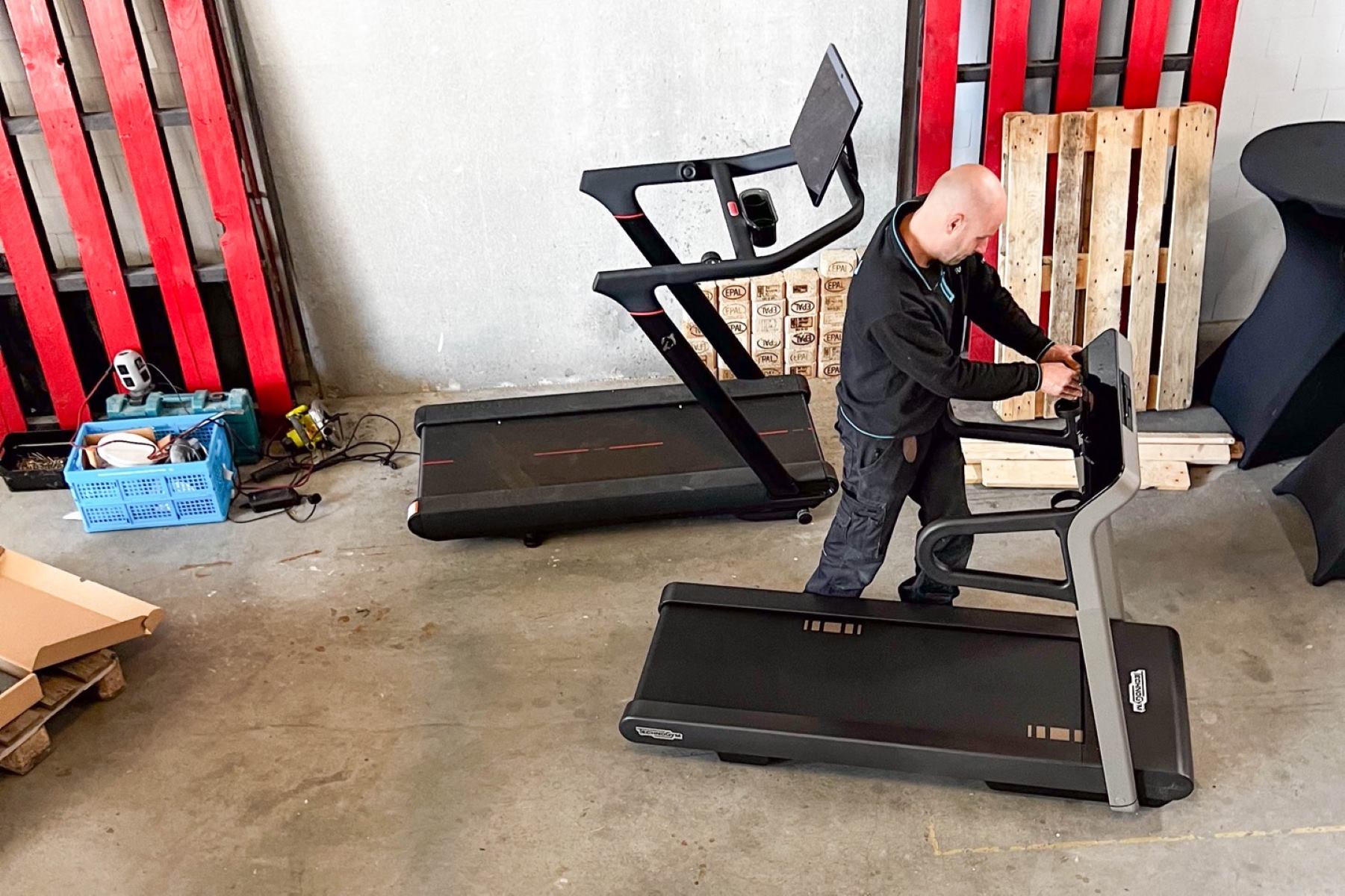

Featured
How To Start Jogging Again
Modified: August 21, 2023
Get motivated and start jogging again with our featured guide. Rediscover the joy of running and achieve your fitness goals with our expert tips and advice.
Introduction
Have you ever felt the urge to lace up your running shoes and hit the pavement? Whether you’re a seasoned jogger or someone who used to enjoy running but fell out of the routine, getting back into the rhythm of jogging can be an invigorating and empowering experience. Not only is jogging a great way to improve cardiovascular fitness, but it also releases endorphins, reduces stress, and helps maintain a healthy weight.
However, starting jogging again after a break can be a daunting task. You may be worried about your current fitness level, unsure about setting realistic goals, or feel overwhelmed by the thought of pushing through the initial discomfort. Don’t worry, though – with the right approach and some gradual training, you can ease back into jogging and regain your stride.
In this article, we will guide you through the process of getting back into jogging and share some valuable tips to help you along the way. From assessing your current fitness level to preventing and managing injuries, we will cover everything you need to know to make your jogging comeback a success.
Before embarking on your jogging journey, it’s important to note that consulting with your healthcare provider is always a good idea, especially if you have any underlying health conditions or concerns. They can provide personalized guidance and ensure that jogging is a safe and suitable activity for you.
So, if you’re ready to dust off your running shoes and hit the road again, let’s dive into the steps to start jogging and rediscover the joy of movement!
Assessing Your Current Fitness Level
Before you begin your jogging journey, it’s important to assess your current fitness level. This step will help you determine where you stand and create a starting point from which you can track your progress. Assessing your fitness level will also assist you in setting realistic goals that align with your abilities.
One way to assess your fitness level is by taking note of your current activity level and endurance. Consider how active you’ve been in recent months and how long you can comfortably engage in physical activity without feeling overly tired or out of breath. This self-reflection will provide you with a baseline understanding of your fitness.
Another effective method to assess your fitness is by performing a simple jog or run for a predetermined distance or time. Pay attention to how your body feels during and after the activity. Take note of your breathing, heart rate, and any discomfort or pain you may experience. This information will help you gauge your cardiovascular endurance and identify areas where you may need to focus your training.
In addition to self-assessment, it’s beneficial to consult with a professional, such as a personal trainer or a certified fitness instructor. They can conduct a more comprehensive fitness assessment, which may include tests like a RAMP (Range of Motion, Agility, Muscular Strength, and Power) assessment or a VO2 max test. These assessments provide valuable insights into your flexibility, strength, and aerobic capacity.
Keep in mind that assessing your fitness level is not about comparing yourself to others. It’s about understanding your starting point and working towards personal improvement. Embrace the journey and trust that with consistency and effort, you will progress and achieve your goals.
Once you assess your current fitness level, you can move forward with confidence and tailor your jogging routine to meet your specific needs and abilities. The next step is setting realistic goals that will guide you towards success in your jogging journey.
Setting Realistic Goals
Setting realistic goals is crucial when starting or restarting a jogging routine. Goals provide direction, motivation, and a sense of accomplishment as you progress. However, it’s important to set goals that are attainable and align with your current fitness level and lifestyle.
One effective approach to goal setting is using the SMART framework. SMART stands for Specific, Measurable, Achievable, Relevant, and Time-bound. Let’s break down each component:
- Specific: Clearly define what you want to achieve. Instead of a vague goal like “get better at jogging,” specify something like “jog 2 miles without stopping.”
- Measurable: Create criteria to measure your progress. This could be distance, time, or the number of jogging sessions per week.
- Achievable: Set goals that are challenging yet attainable. Consider your current fitness level and gradually increase the difficulty as you progress.
- Relevant: Ensure that your goals align with your overall health and fitness objectives. Think about how jogging fits into your lifestyle and supports your wellbeing.
- Time-bound: Set a timeline or deadline for achieving your goals. This adds a sense of urgency and helps you stay motivated.
For example, a SMART goal for someone just getting back into jogging could be: “In the next four weeks, jog for 20 minutes, three times a week, gradually increasing the duration and intensity.”
Remember, everyone’s journey is unique, and what may be realistic for one person may not be for another. Be honest with yourself about your abilities and limitations. It’s better to start with smaller goals and gradually work your way up, rather than setting unrealistic expectations and risking burnout or injury.
In addition to long-term goals, it’s essential to set smaller, incremental goals along the way. These short-term goals keep you motivated and provide a sense of achievement as you reach them. Celebrate each milestone along your jogging journey, whether it’s running for an extra minute or completing a specific distance.
By setting realistic goals, you set yourself up for success. Your goals will serve as a roadmap for your jogging journey and keep you inspired to keep moving forward. Now that you have your goals in mind, let’s move on to the next step: choosing the right gear for your running endeavors.
Choosing the Right Gear
When it comes to jogging, having the right gear can make a significant difference in your comfort, performance, and overall enjoyment of the activity. The following are key factors to consider when selecting the right gear for your jogging routine:
- Running Shoes: Invest in a good pair of running shoes that provide adequate support, cushioning, and stability. Visit a specialty running store or consult with a professional to ensure you choose the right shoes for your foot type and running style.
- Comfortable Clothing: Opt for moisture-wicking and breathable fabrics to keep you comfortable during your jog. Choose clothing that allows for a full range of motion and prevents chafing or irritation.
- Appropriate Socks: Choose socks made of moisture-wicking materials to keep your feet dry and prevent blisters. Look for socks with cushioning and arch support for added comfort.
- Safety Gear: If you plan to jog during low-light conditions, make sure to wear reflective clothing or accessories to enhance your visibility to motorists. Consider using a headlamp or carrying a flashlight to illuminate your path.
- Music or Podcasts: If you enjoy listening to music or podcasts while jogging, invest in a comfortable pair of wireless headphones or a running armband to hold your phone. Choose earbuds that stay securely in place during physical activity.
- Accessories: Depending on your needs, you may consider additional accessories such as a running watch or fitness tracker to monitor your progress, a hydration belt or water bottle for staying hydrated, and a running belt or armband to carry essentials like keys, ID, or a phone.
Remember that everyone is unique and has different preferences and requirements. What works for one person may not work for another. Take the time to experiment with different brands and styles to find the gear that feels comfortable and suits your needs best.
Additionally, as you start jogging again, pay attention to how your body responds to the gear you are using. If you are experiencing discomfort or pain, consider reassessing your choices. Investing in high-quality gear may seem like an added expense, but it can significantly enhance your jogging experience and help prevent common injuries.
Now that you are equipped with the right gear, it’s important to prepare your body for the physical demands of jogging. The next section will cover the importance of proper warm-up and cool-down routines.
Proper Warm-Up and Cool-Down
Before diving into your jogging routine, it’s essential to prioritize proper warm-up and cool-down exercises. Warm-up exercises help prepare your body for the activity by increasing your heart rate, loosening up your muscles, and improving joint mobility. Cool-down exercises, on the other hand, aid in gradually bringing your heart rate back to its resting state and preventing muscle soreness.
Here are some key points to remember when it comes to warming up and cooling down:
- Warm-Up: Start with 5-10 minutes of light aerobic exercises such as brisk walking, gentle jogging, or jumping jacks. This helps elevate your heart rate and increase blood flow to your muscles. Follow this with dynamic stretches that target the major muscle groups involved in jogging, such as leg swings, walking lunges, or arm circles. Dynamic stretches involve rhythmic movements that take your joints through a full range of motion without holding a static stretch.
- Jogging Phase: Once you have completed your warm-up, ease into your jogging routine gradually. Begin with a comfortable pace and gradually increase your speed or intensity as your body adjusts to the movement.
- Cool-Down: After your jogging session, gradually reduce your speed to a brisk walk or slow jog for about 5-10 minutes. This will allow your heart rate to gradually decrease and prevent blood from pooling in your lower extremities. Finish your cool-down with static stretches, holding each stretch for 15-30 seconds. Focus on stretching your calves, quadriceps, hamstrings, and hip flexors. This helps improve flexibility and reduces muscle tightness.
Proper warm-up and cool-down routines can significantly reduce the risk of injury and improve your overall jogging experience. They prepare your body for the demands of the activity and aid in muscle recovery. Don’t rush through these phases, as they play a crucial role in optimizing your performance and minimizing post-exercise discomfort.
Stay tuned for the next section, which covers building up your endurance and gradually increasing your jogging duration and intensity.
Building Up Your Endurance
Building up your endurance is a key component of getting back into jogging and progressing towards longer, more challenging runs. By gradually increasing your jogging duration and intensity, you can improve your cardiovascular fitness, strengthen your muscles, and enhance your overall endurance.
Here are some tips to help you build up your endurance effectively:
- Start Slow and Gradual: Don’t push yourself too hard from the beginning. Begin with a pace and distance that feels comfortable for you, even if it’s just a few minutes of jogging. Focus on maintaining good form and breathing rhythmically.
- Follow the 10% Rule: Increase your jogging duration or distance by no more than 10% each week. This gradual progression allows your body to adapt to the demands of jogging without overloading your muscles and cardiovascular system.
- Alternate Jogging and Walking: If jogging continuously feels too challenging at first, incorporate walking intervals into your routine. Start with a jog-walk ratio that suits your current fitness level, such as jogging for 2 minutes and then walking for 1 minute. As your endurance improves, gradually increase the jogging interval and reduce the walking interval.
- Listen to Your Body: Pay attention to how you feel during your jog. It’s normal to experience some fatigue and muscle soreness, but be mindful of any persistent pain or discomfort that may indicate an injury. If needed, adjust your jogging routine or take rest days to allow your body to recover.
- Include Cross-Training: Incorporate other forms of cardiovascular exercise, such as cycling, swimming, or elliptical training, into your weekly routine. Cross-training helps prevent overuse injuries and enhances overall fitness by targeting different muscle groups.
- Avoid Comparisons: Remember that everyone’s progress is different. Focus on your own journey and celebrate the improvements you make along the way. Don’t compare yourself to others or get discouraged if your progress seems slower. Consistency and dedication will yield results.
Building up your endurance takes time and patience. Trust the process and embrace the incremental improvements you make. As your jogging duration and intensity increase, you’ll begin to notice improvements in your overall fitness and stamina.
In the next section, we’ll explore the benefits of incorporating interval training into your jogging routine to further enhance your fitness level.
Incorporating Interval Training
Incorporating interval training into your jogging routine is an effective way to boost your endurance, increase your speed, and challenge your cardiovascular system. Interval training involves alternating between periods of high-intensity effort and periods of active recovery. By pushing your body to work harder during the high-intensity intervals, you can improve your aerobic capacity and overall performance.
Here are some key points to keep in mind when incorporating interval training into your jogging:
- Start with a Warm-Up: Begin with a proper warm-up routine to prepare your body for the upcoming intervals. This can involve 5-10 minutes of light jogging or dynamic stretching exercises.
- Choose an Interval Structure: There are various interval training structures you can implement, such as the 1:1 ratio (equal work and rest periods), the pyramid structure (increasing then decreasing intensity), or the variable pace structure (alternating between different intensity levels).
- Set Intensity Levels: Determine the intensity level of your high-intensity intervals. This can range from a comfortably challenging pace to a near maximum effort. The duration of the intervals typically ranges from 30 seconds to a few minutes, depending on your fitness level and goals.
- Include Active Recovery: During the active recovery periods, jog or walk at a slower and more relaxed pace. This allows your body to recover and prepares you for the next high-intensity interval.
- Gradually Increase Intensity and Duration: Start with shorter interval durations and gradually increase both the intensity and duration as you build your endurance. For example, you could start with 30-second sprints followed by 1-minute active recovery periods and gradually increase to 1-minute sprints with 2-minute recovery periods.
- Listen to Your Body: As with any form of exercise, it’s important to listen to your body and adjust the intensity as needed. Don’t push yourself to the point of exhaustion or pain. Remember that rest and recovery are just as crucial as the workout itself.
Incorporating interval training not only improves your cardiovascular fitness but also adds variety and excitement to your jogging routine. It challenges both your body and mind, keeping you engaged and motivated.
As you progress with interval training, you’ll notice improvements in your overall endurance, speed, and ability to sustain higher intensity levels. Stay consistent, push yourself within your limits, and enjoy the benefits that interval training brings to your jogging routine.
Next, we will discuss the importance of listening to your body and adopting a mindful approach to your jogging practice.
Listening to Your Body
When it comes to jogging or any physical activity, it’s essential to listen to your body. Your body communicates its needs and limits through various signals, and paying attention to these signals is crucial for your overall wellbeing and injury prevention.
Here are some key aspects to keep in mind when it comes to listening to your body:
- Recognize the Difference Between Discomfort and Pain: It’s normal to experience muscle soreness or fatigue during and after jogging. However, it’s important to differentiate between general discomfort associated with pushing your limits and actual pain that signals potential injury. If you experience sharp or persistent pain, it’s essential to stop and seek professional advice.
- Respond to Fatigue and Rest when Needed: Pushing through extreme fatigue or feeling constantly exhausted can be detrimental to your overall health. Listen to your body’s signals for rest and recovery. Incorporate regular rest days into your routine and prioritize sleep for optimal recovery.
- Adjust Your Intensity and Pace: If you find that your body is struggling to maintain the intensity or pace you initially set, don’t be afraid to adjust and slow down. It’s better to complete a jog at a comfortable pace than to push too hard and risk injury or burnout.
- Stay Hydrated and Fuel Your Body Properly: Listen to your body’s signals for thirst and hunger. Hydrate before, during, and after your jog. Fuel your body with adequate nutrition to support your energy levels and recovery.
- Pay Attention to Joint Health: Joints can be prone to injury, especially during high-impact activities like jogging. If you experience recurrent joint pain or discomfort, consider incorporating low-impact exercises or cross-training activities to reduce strain on your joints.
- Seek Professional Guidance: If you have chronic health conditions, previous injuries, or concerns about specific aches or pains, consult with a healthcare professional or a qualified fitness trainer. They can provide tailored advice and guidance to ensure your jogging routine is safe and suited to your individual needs.
Remember, jogging is a journey that should be enjoyable and sustainable. By listening to your body and responding to its needs, you can develop a healthier relationship with exercise and prevent potential setbacks.
Now that you have a better understanding of how to listen to your body, we will delve into the next section, which focuses on preventing and managing injuries during your jogging routine.
Preventing and Managing Injuries
When engaging in any physical activity, including jogging, it’s crucial to prioritize injury prevention. By taking proactive steps to prevent injuries and knowing how to effectively manage them, you can ensure a safe and sustainable jogging routine.
Here are some key measures you can take to prevent and manage injuries:
- Proper Warm-Up and Cool-Down: As mentioned earlier, warming up before your jog and cooling down afterwards helps prepare your body for the activity and reduce the risk of strains or sprains. Incorporate dynamic stretches and gradually increase the intensity of your jog.
- Strength and Conditioning Exercises: Incorporate strength and conditioning exercises into your routine to improve muscular strength and stability. Focus on exercises that target the major muscle groups used in jogging, such as squats, lunges, planks, and calf raises.
- Progress Gradually: Avoid sudden increases in mileage, speed, or intensity. Gradually build up your endurance and distance over time to allow your body to adapt and minimize the risk of overuse injuries.
- Listen to Your Body: Be aware of any warning signs or pain during your jogging sessions. If you experience persistent pain or discomfort that worsens with activity, it’s essential to take a break and seek professional advice if needed.
- Wear Proper Footwear: Invest in a good pair of running shoes that provide adequate support and cushioning for your foot type and running style. Replace them regularly to ensure optimal shock absorption and reduce the risk of foot and lower limb injuries.
- Cross-Train and Rest: Incorporate cross-training activities, such as swimming or cycling, into your routine to allow for active recovery and minimize overuse injuries. Additionally, take regular rest days to give your body time to repair and recharge.
- Listen to Expert Advice: If you experience pain or suspect an injury, consult with a healthcare professional or a qualified sports medicine specialist. They can assess the injury, provide appropriate treatment, and offer guidance on rehabilitation exercises.
By adopting these preventive measures and staying attentive to your body’s signals, you can reduce the risk of injuries during your jogging routine. Prioritizing injury prevention is essential for long-term success and enjoyment of the activity.
In the next section, we will explore some effective strategies to stay motivated and maintain consistency in your jogging practice.
Staying Motivated
Maintaining motivation is crucial when it comes to sticking to your jogging routine. While it’s normal to have ups and downs in motivation, adopting strategies to stay motivated can help you stay consistent and on track towards achieving your jogging goals.
Here are some effective strategies for staying motivated:
- Set Realistic and Meaningful Goals: Continually remind yourself of why you started jogging and set achievable goals that resonate with your values and aspirations. This will keep you focused and motivated to work towards something meaningful.
- Create a Schedule: Plan your jogging sessions in advance and treat them as non-negotiable appointments with yourself. By incorporating jogging into your daily or weekly routine, it becomes a habit that you’re more likely to stick to.
- Vary Your Routes: Explore different routes and environments to keep your jogging experience fresh and exciting. Discover new trails, parks, or running paths in your area to add variety to your routine.
- Find a Running Partner or Join a Group: Having a running buddy or joining a running group can provide accountability, companionship, and motivation. Working out with others can make the experience more enjoyable and help you push through challenging moments.
- Track Your Progress: Keep a record of your runs, distances, and personal bests. Seeing your progress over time can be highly motivating and give you a sense of accomplishment. Consider using a running app or a fitness tracker to monitor your stats.
- Reward Yourself: Celebrate your milestones and achievements along the way. Treat yourself to something you enjoy after accomplishing a specific goal, whether it’s a new piece of workout gear, a massage, or a favorite healthy meal.
- Keep Things Fun and Enjoyable: Find ways to make your jogging routine enjoyable. Listen to your favorite music, podcasts, or audiobooks. Use the time to disconnect from screens and immerse yourself in the beauty of nature or your surroundings.
- Practice Self-Compassion: Be gentle with yourself on days when you feel less motivated or when things don’t go according to plan. Understand that setbacks are part of the journey, and it’s okay to take a break or adjust your goals if needed. Show yourself kindness and encouragement along the way.
Remember that motivation may fluctuate, and that’s okay. It’s normal to have days when you feel less motivated or face obstacles. The key is to find strategies that work for you and to keep reminding yourself of the benefits of jogging for your physical and mental well-being.
In the final section, we’ll summarize the key points discussed and wrap up your journey towards starting jogging again.
Conclusion
Congratulations on taking the first steps towards restarting your jogging routine! We’ve explored various aspects of getting back into jogging, from assessing your current fitness level to setting realistic goals, choosing the right gear, and incorporating proper warm-up and cool-down routines. We’ve also discussed building up your endurance, incorporating interval training, listening to your body, preventing and managing injuries, and staying motivated.
Remember, the road to becoming a consistent jogger is a personal journey that requires patience, perseverance, and self-care. Start slow, listen to your body, and gradually increase the intensity and duration of your jogging sessions. Be mindful of your goals and enjoy the process of improving your fitness and overall wellbeing.
Always prioritize your safety and consult with a healthcare professional before beginning any new exercise regimen. They can provide personalized guidance and address any concerns or specific considerations related to your health.
So, lace up your running shoes, hit the pavement, and embrace the joy of jogging once again. Let the rhythmic sound of your footsteps and the sense of accomplishment inspire and motivate you along the way. Happy jogging!








